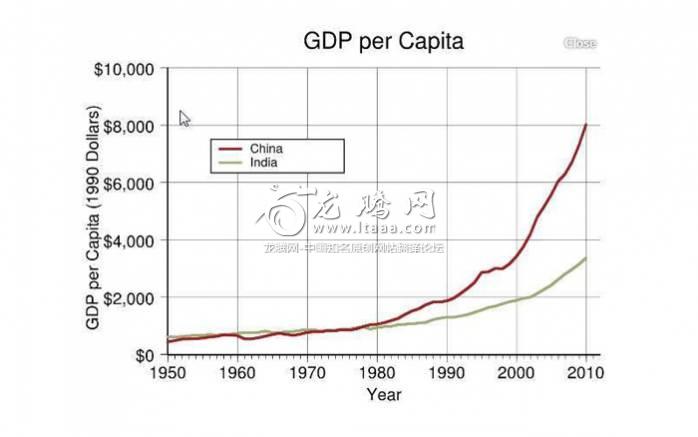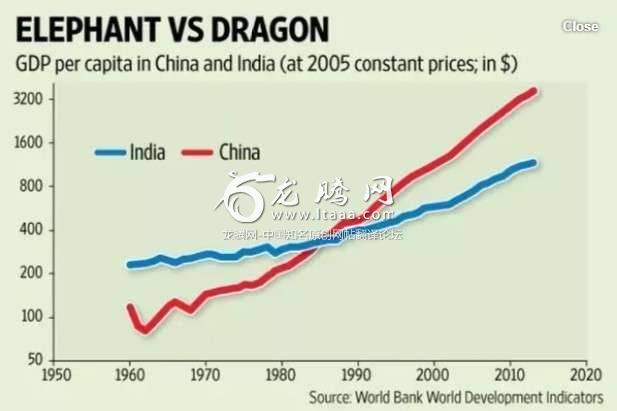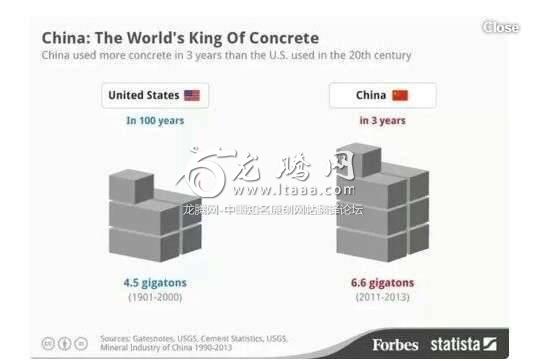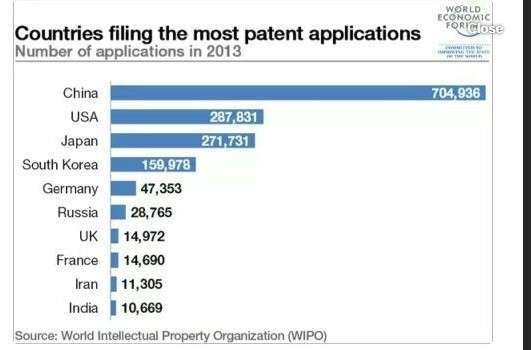印度应该向中国学习吗? [美国媒体]
quora网友:技术上说,是的,印度需要向中国学习。以下10件事是我们能向中国学习的。10.交通运输:中国已经发展出了值得骄傲的、独特的交通运输系统。中国的铁路网是世界最好的,其子弹头列车使得市民只需要数小时就可以长距离通勤成为可能。而公共交通也要比印度的好,而航空网也比印度的更广泛......
Should India learn from China?
印度应该向中国学习吗?
Gangesh Shukla, Senior officer marketingAnswered Aug 11, 2017
Not like this , China must be learn from india , I am giving some example why .
1 : There is no freedom of speech . that they can learn from india .
2:From 2009 they have ban fb and google and other social sites , and resist his people they can only listen which his goverment wants .
2:you should know in China sucide case is too much , even you can get a job to search a dead body form rivers .
3: If you made any crime and get punished from court , and you have money , you can send other person in Jail instead of you .
4: As per Chinese except table and chairs , you can eat each and every thing those who are having 4 legs ..as per one article in once in a year they organizing one dog meet festivals and that day only they eat 10 lack dog in that particular day . same thing they are doing with cat also .
5: In Bijing city pollution level is too high , one day stay in city is compare to use 21 cigrate ..
6: Chinese are having conflict with with all the Neighbor.
I am not good in english ,so sorry , but hope guys you can understand what I want to say …
Gangesh Shukla 销售高管
并非如此,相反中国必须向印度学习,我会给出具体的理由。
1.那里没有演讲的自由。这是他们能向印度学习的地方。
2.自2009年以来,他们已经屏蔽了非死不可、谷歌等社交媒体,迫使他的人民只能听到zf想要告诉他们的信息。
3.你得知道,在中国自杀事件层出不穷,你甚至可以得到一份从河里打捞尸体的工作。
4.如果你犯了法,已经得到了法庭的制裁,然而你有钱,你就能找人替你进监狱。
5.除了桌子椅子,只要是4条腿的他们什么都吃……每年这里都要组织一次狗肉节,这一天他们每个人都要10条狗。猫也同样遭此厄运。
6.在北京,污染水平太高了,在这座城市待一天就相当于抽了21支烟。
我英语不算好,很抱歉,但希望人们能理解我想要表达的意思……
Ashim Kumar, Software Developer -Chrome,Mozilla Extensions,Android AppsAnswered Dec 12Technically Yes!
Here is a list of 10 things which We can learn from China.
10. Transportation:
The way China has evolved its transportation model is worth loads of praise. China’s railway network is among the world’s best, and bullet trains make it possible for the countrymen to commute long distances within a few hours. The public transport is way better than India’s and air network is comprehensive unlike us.
9. Population control:
China owns the tag of most populous country in the world and India only finishes next to it giving it a close finish. Conversely, it would not take India a longer time to emerge as the country with most number of people. There are around 1.35 billion in China as compared to more than 1.2 billion in India presently. However, the way China has curbed the spiral rise of its population introducing various measures (one child norm, strict penalties, no citizenship to the third new born etc.) is worth teaching point or two to India.
8. Cleanliness:
Shanghai is the business capital of China and Beijing is the national capital. Those who have travelled to these cities would surely agree to a point that they were umpteen times better than Mumbai and Delhi respectively on the infrastructural and cleanliness index. Indians should take a leaf out of the book of Chinese nationals about how to keep country litter free and tidy.
7. Aggression:
The way China puts forward its point of view in front of the world is worth praising. It follows an aggressive posture in case the other nation is showcasing belligerent stance against it. As in the case of dispute with its neighbors (Philippines and Vietnam); China has been straight forward in putting across its viewpoint. This is what India needs to learn from China especially while dealing the turbulent relationship with Pakistan.
6. Education and research:
Despite the largest system in the world in terms of undergraduate (bachelor’s) enrollment in the degree system, India lacks in quality education set up. The present situation of vocational education is poor in the country. While China enrolls around 96 lakh students in vocational courses we only enroll around 40 lakh. In addition, China spends around 2% of its GDP on research work where the number is only around 1% in case of India.
5. Health system:
China faced similar problems as India is facing at present for most part of its existence post independence. However, with execution of proper medical and insurance policies and improvement in the medical sector of the country China achieved what was termed as impossible by the Western powers. The medical insurance cover has been increased to 95.7 percent in 2012 from low 29.7 percent in 2003.
4. Diplomacy:
Chinese are famous the world over for their diplomatic acumen. The way they have augmented their stronghold over almost all the parts of South Asia shows how well they design their diplomatic policies. The recent rebuff Indian company GMR received at the hands of small island nation named Mauritius (on the backing of China) itself shows they exhibit no nonsense attitude on the diplomatic front.
3. Disciplined execution of policies:
India is good at churning out policies, but the way implementation is carried out is pathetic. A great number of loopholes are left intact in the national policies for the law breakers to make their way into. This has left our country into a banana republic and policies are a matter of making money than progressing nation forward. Whereas, the Chinese associate proper execution of national policies with overall development of the country. They attribute success of policies with increase in revenue that could further result in increase in per capita income of the country.
2. Manufacturing policies:
The way China is dominating the world order with its immaculate manufacturing power (low volume and low cost based) is just next to brilliant. The way it prepares and executes its manufacturing policies leaves a lot for India to learn from. The best part is that China offers huge incentives to the manufacturing companies in the country through the SEZ’s and manufacturing rebates and this is what has made it a global manufacturing leader. The national manufacturing policies of India should be drafted keeping China in the backdrop because two decades ago, China too faced the same problems as we do at the moment.
1. Infrastructure development:
China is all set to take over US in a decade or less as the largest economy in the world. The main reason behind its spiraling growth rate is the magnificent and robust infrastructural set up it possesses. It is what led to its mercurial rise in the exports as ports, roads and railways tracks are of the top most class. On the other hand India is still battling with poor infrastructural set up despite investing crores since the time of independence. What India must learn from China on the foremost basis is that corruption is the root evil in almost all the nations in the world, but when it comes to infrastructure, we need proper development.
Ashim Kumar 软件开发
技术上说,是的,印度需要向中国学习。
以下10件事是我们能向中国学习的。
10.交通运输
中国已经发展出了值得骄傲的、独特的交通运输系统。中国的铁路网是世界最好的,其子弹头列车使得市民只需要数小时就可以长距离通勤成为可能。而公共交通也要比印度的好,而航空网也比印度的更广泛。
9.人口控制:
中国是世界上人口最多的国家,而印度紧随其后。印度要成为人口最多也花不了多少时间了。当前,中国是13.5亿人口,而印度是12亿。然而,中国通过各种各样措施(一胎政策、精确的惩罚、生三孩取消公民身份)已经抑制住了人口的螺旋上升,这点值得印度借鉴一二。
8清洁:
上海是中国的金融首都,而北京是国家首都。任何去过这些城市的人都同意,它们在基础设施和清洁指数方面,要比孟买和德里好无数倍。印度人需要从中国公民身上学习如何让国家保持整洁。
7.侵略好斗
值得骄傲的是,中国提出自己的观点。一旦其他国家展现出交战的立场,中国就会采取好斗姿态。在与其邻国的冲突之中,中国直截了当的达成了其目的。这是印度需要从中国学习的地方,尤其是解决跟巴基斯坦的混乱关系。
6.教育和研究:
印度除了是世界上在册大学生最多之外,其并没有建立起教学质量体系。当前这个国家的职业教育非常贫乏。而中国每10万人就有96人接受职业教育,而我们只有40人。再者,中国将其GDP的2%投入到研究工作,而印度只有1%。
5.卫生系统
自印度独立以来所面临的问题,中国也差不多面临着同样的问题。然而,通过施行合适的医疗保险政策,以及促进国家医疗部门的发展,中国实现了西方国家不可能达到的地步。其医疗保险覆盖率增长到了95.7%,相比于2012年只有29.7%。
4.外交
中国以外交智慧而名闻世界。他们把自己的要塞扩张到了几乎整个南亚地区,来展示他们设计的外交政策有多么的成功。当前断然拒绝印度公司GMR的要求的就出自一个叫毛里求斯的国家(有中国撑腰),中国展示了自己在外交上没有任何无意义的姿态。
3.严格执行政策:
印度擅长炮制政策,但被执行的数量少得可怜。国家政策完整保留了大量的漏洞,使得法律破坏者有了可乘之机。这把印度变得香蕉共和国,其政策对钱的在乎超过了国家进程。然而, 中国通过国家的全面发展来执行政策。政策的成功使得税收增加,这更进一步会增加国家的人均收入。
2.制造业政策:
中国用自己完美的制造业实力主导了世界秩序。其对制造业政策的准备和执行,有很多都是印度需要学习的。其中最好的一部分是中国通过经济开发区和税收减免来刺激其制造业公司。这使得中国成为全球制造业的领头人。印度的国家制造业政策在在制定过程中需要以中国为模版,要知道20年前,中国也面临我们这时所面临的困境。
1.基础设施的发展:
中国准备好在接下来的十年里超越美国成为世界最大经济体。其背后的主要原因在于可观的经济增长率和强健的基础设施。正是因为其出口产品如港口、道路、铁路轨道是世界顶尖级别的,才使得其增长如此迅速。
另一方面,印度依然在与其贫乏的基础设施作斗争,除了自独立以来在基础设施上投入了1000万卢比之外什么都没有。
印度必须向中国学习的最重要的一点就是:腐败几乎是世界所有国家的邪恶之源,但当涉及到基础设施之时,我们就需要合适的发展。
Giridharan Velamore, A complete Indian by spiritAnswered Nov 30, 2016
Question: Should India learn from China?
Question detail: India was ahead of China in the 80’s. And now China is ahead of even the US.
Answer: Sorry, I doubt if the Question detail is right. If you have any reference, please share it. Historical GDP of China - Wikipedia.
In fact till 1980, both economies had been more or less equal and they took a zoom afterwards. Why? Chairman Mao Zedong had died in 1976 and after that Huo Guofeng, his designated successor followed. He was unimaginative and came up with, Two Whatevers - Wikipedia. Then Chairman Deng Xioping came and he introduced Four modernizations (in Agriculture, Industry, Science and Technology) and Socialism with Chinese characteristics. Basically it was economic reforms and opening up.
In the case of India, our economic reform had not started until 1991 - a decade after China’s headstart. It happened during the time of the great PM, Mr. Narasimha Rao and the great economist (but sadly an unimpressive PM) Dr. Manmohan Singh.
Can we learn from China? Yes, we can. And as Sharath mentioned, we are doing it. We created Special economic zones and Export processing zones looking at Chinese model. We will have to adopt it to suit our needs.
Our economic reforms was driven by a crisis. In the case of China it was a different political decision taken by paramount leader, Deng Xioping. It was a different path from that of Mao Zedong or Huo Guofeng.
We have to bear in mind that India is a democracy and China has an authoritarian rule. With an authoritarian rule, they can implement many things much more quickly than India. I don’t think India can choose an authoritarian rule like them. It will simply fail. Indians will never accept it and anyone who tries is will fail before it even starts.
Giridharan Velamore 纯粹的印度人
你的问题是:印度需要向中国学习吗?
问题细节:印度在上世纪80年代领先于中国。而如今中国甚至已经领先于美国。
我的答案:抱歉,我怀疑这个所谓的“问题细节”是否是对的。如果你有任何参考资料,请提供出来。
事实上,直到上世纪80年代,两国(中印)的经济都差不多,之后他们都进入的发展的快速轨道。为何会这样呢?自毛主席与1976年去世,指定的继任者是华,他缺乏建设性并追随“两个凡是”的方针。之后邓主席登台,他引入了“四个现代化”(农业、工业、科学和技术)以及中国特色社会主义。简单说就是经济是改革和开放。
而印度,我们的经济改革并不是始于1991年。而是发生于伟大的纳拉辛哈·拉奥总理执政期间,还有伟大的经济学家曼莫汉·辛格博士的功劳(遗憾的是他没有前者有名)。
(译注:纳拉辛哈·拉奥,即帕穆拉帕提·文卡塔·纳拉辛哈·拉奥(Pamulaparthi Venkata Narasimha Rao)(1921年6月28日 – 2004年12月23日),印度总理(1991~1996)。 拉奥属婆罗门种姓。),
我们能向中国学到什么吗?当然能。正如Sharath所提到的那样,我们正在这么做。我们创立了中国模式的经济特区,出口加工。我们不得不这么做来适应自己的需求。
我们的经济改革是由危机来驱动的。而中国则是完全不同的政治决策,它由最高领导人邓来做出决定。这与之前的毛和华是不一样的。
我们还要记住的是,印度是皿主政体而中国是毒菜统治。通过毒菜统治,他们能以印度快得多的速度实施各个政策。我认为印度没法像他们那样成为毒菜国家。它失败了。印度人绝不会接受它的,任何想要这样尝试的都会如过去那样失败。
Gurasees Singh, Student at Punjab Engineering College,Chandigarh (2016-present)Answered Jan 26
Every country or a political system has its own ups and downs.
There is always a room for improvement though.
Every time I think about China and India,I remember the time of 1970s, how the two economies used to be at par and how both had the same development rate. But, by the end of 1977,the graph changed.
In February of 1978 Chairman Hua Guofeng revealed a ten year plan for the period 1976-1985.
The Plan involved 120 projects:
Iron and Steel:10 complexes
Nonferrous Metals:9 complexes
Oil and Gas:10 fields
Coal:8 mines
Electricity:30 power stations
Railroad:7 trunk lines
Water Transportation:5 harbors
In 1977 China was still a predominantly agricultural economy but the government had not supported institutional and technological measures to increase productivity and, as a consequence, per capita production of grains had remained at 1955 levels. The Ten-Year Plan called for a $33 billion investment in the mechanization of agriculture and improvement of irrigation. One important side-effect of this program is that if it worked there would be 100 million workers who would be released from farming and for whom the government would have to make provisions for in other sectors. The institutional structure was modified to encourage higher production through individual initiative and more flexible production arrangements. Commune farmers were encouraged to pursue sidelines of production on small plots.
China turned to encouraging foreign investment as a way of financing the development projects. German and Japanese companies provided the capital for major projects in return for a share of the benefits.
Moreover,when soviet unx broke down,China bought the best of best metallurgy enggineers,nuclear scientists and other specialised personnels of the unx.
This overall led to drastic sudden growth.
China became a business hub, and a country that had earlier been just a large piece of land, influenced by other colonials turned into a world super power.
The sense of nationalism that the chinese have and the effective,but dictating leadership of the communist party further boosted the process.
Now, with respect to the above facts,I feel India can learn a lot from China .
There are tons of problems in India, let it be corruption, overpopulation, reservations, and many others, but what are the root problems???
Bad Politics and lack of nationalism in the citizens!!!
The leadership is corrupted and indulges in the policy of vote banks and other practices of bad politics. The very citizens blindly follow these dirty leaders and thus deviate from the path of development. Nationalism is not inculcated by saying “Bharat Mata ki Jai”. It is when you work for your country keeping your personal gains aside. The government should be of the people,by the people, for the people.
Effective leadership, hardcore positive nationalism, heavy FDIs,ending reservations and focussing on metallurgy can be some of the things India can learn from China
Gurasees Singh 旁遮普工程学院学生(2016年-至今)
任何一个国家或一个政治体系都有其优点和缺点。
总能找到改进的空间。
每当我想到中印,我就会回想起上世纪70年代,两国经济水平、发展水平曾经多么的相似,但1977年之后,曲线图就变了。
1978年2月,华主席提出了1976-1985年的十年计划。
该计划涉及120个项目:
钢铁、有色金属、石油天然气、煤炭、电力、铁路、水上交通。
1977年,中国依旧是农业为主的经济体,但zf不再为提升生产率提供政策和技术上的支持,其结果是人均谷物产量维持在了1955年的水平。
十年计划需要为农业机械化和提升灌溉技术投入330亿美元。这个计划的一个重要的副作用就在于从农田中释放了1亿劳动人口,而zf必须让其他行业为此做好准备。
制度结构被调整为,通过鼓励个人主动性和更加灵活的生产调整,来鼓励更高质量的产品。公社农民们被鼓励在小块土地上继续从事生产副业。
中国转变为鼓励外国投资,通过这种方式来为发展项目筹措资金。德国和日本公司为主要项目提供资金,作为回报,利益共享。
此外,自苏联崩溃之后,中国就雇佣了其中最好的冶金学工程师、核科学家和一些专门领域的工作人员。
以上所有因素,导致了突然地剧烈增长。
中国,一个早期只有大片土地并受到殖民影响的的国家,一举成了商业中心。
民族主义情绪以及CCP领导人进一步巩固了这个进程。
现在,基于对以上事实的尊重,我认为印度要向中国学习的东西有很多。
印度存在堆积如山的问题,比如腐败、人口过多、预留制、等等,但问题的根源在哪儿???
国民糟糕的政治和民族主义的缺乏!!!
领导人的腐败、沉迷于选票政治和其他一些糟糕的政治行为。正是盲目的市民跟随这些肮脏的领导人,导致偏离了发展轨道。民族主义不是反复喊一喊“印度万岁”就算完了。民族主义是你基于自己的利益而为你的国家工作。Zf理应源于人民、授于人民、服务于人民。
有效领导、直接又积极的民族主义、大量国外直接投资(FDI)、废除预留制、把精力集中于冶金,是印度可以向中国学习的一些方面。
Sureya Vayshnava KumarAnswered Jul 21, 2017
Nice question. The Indian economy and Chinese economy are vastly similar in various aspects and it is widely regarded that India is at the position where China was 2 decades ago. Looking at the economies alone one would prudently derive from logic that India should go the Chinese way to dig into fortunes, however one cannot overlook the social demographics and domestic issues of India which are vastly different from China.
One cannot also look away from the fact that India is a democracy where the people have enormous liberties in deciding the government policies whereas the Chinese government is an authoritarian government which provides reasonable liberties. For example, the recent plan of issuing Biometric ID cards (Aadhar cards) for citizens to avail subsidies and benefits of government schemes has met with stringent opposition by the people. Whereas the Chinese government can dexe and block WhatsApp messages of Chinese government.
Another thing I must point out is that even though Indian economy was ahead of China, although not by much in the 1980’s it was not as if India was doing better than China but rather the case of Chinese doing much worse than India. India was growing at slower late of like what 3% compared to the world’s globalization induced growth of 5%. The reason for India’s slow growth were protectionism, flawed attachment to socialism, internal tussles and a foreign policy which put us in the ire of world power ( We liberated Bangladesh, did not pick sides in cold war, also did not join Vietnam war etc.) and as for Chinese - let us say they just had misplaced priorities.
Also similarly,the growth of Chinese economy does not mean that India is doing bad but rather the Chinese are doing better. In the past 2 decades India has been growing at an average of 6–7 which is quite good in my books. Also when the world is slowing down and even China is growing at 6–7, Indian economy is stable.
Nevertheless, India is learning a lot from Chinese growth. That is why we have opened up our markets with 100% FDI in various sectors and inviting overseas investors (including Chinese) to set up factories. The ease of doing business has also being taken care of. Make in India has largely been successful till now and I hope it takes off to further heights. The government is also pushing in right directions with privatizing lot of government machinery according to PPP model and spending on infrastructure.
In the end I would say that India cannot rapidly transform as Chinadid and should not as well but India is on the path to become one of the major powers along with China, and hopefully one of the most peaceful ones to do so.
It is only elementary to see that 21st century is where the centre of power shifts to Asia.
Sureya Vayshnava Kumar
不错的问题。
印度和中国的经济在很多方面都有很多共同之处,印度普遍被视为20年前的中国。仅从经济角度看,人们就会谨慎地得出印度应该走中国的道路去寻找机遇的逻辑。然而人们无法忽视的是印度的社会人口统计和国内问题,这点跟中国完全不同。
最近为公民发放生物识别身份证(Aadhar卡片)的计划遭到了民众的强烈反对,该计划旨在让公民享受zf计划的补贴和福利。到了中国zf,就可以删除和屏蔽有关中国zf的WhatsApp消息。
另一点我必须要指出来的是,上世纪80年代印度经济还走在中国的前面,尽管并不比中国多多少,但也不代表印度做得比中国更好,相反宁愿说那时的中国做得比印度糟糕得多。
印度当时的经济增长相比于世界经济增长5%,只有3%。其缓慢的经济增长原因得归功于保护主义、有缺陷的社会主义、内部纷争,以及使我们对世界强国感到愤怒的外交政策(我们解放了孟加拉、冷战期间不选边站、也没有加入到越南战争等)。而(当时的)中国人则搞错了发展的优先顺序。
同样相似还在于,中国的经济增长与其说是印度做得不好,倒不如说中国做得更好。在过去20年里,印度平均增长率在6-7%,依我看这相当不错了。此时世界经济增长下滑,即便是中国的增长也降到了6-7%,印度经济是稳健的。
然而,印度可以从中国的增长中学到很多东西。这也就是为什么我们100%开放自己众多行业的市场,邀请海外投资者(包括中国人)来这里开办工厂。经商的便利性也被考虑了进来。“印度制造”很大程度上也是成功的,我希望未来它能进一步提高比重。根据购买力平价以及在基础设施上提供资金,Zf私有化大量zf机构,这走在了正确的方向上。
最后我得说,印度无法迅速过渡到中国这样,也不应该这么做。但印度会随中国一道成为主要的强权,也希望印度能成为最为爱好和平的其中一个国家。
众所周知的是,21世纪是权力向亚洲转移的世纪。
Shilpa Singh, I love my country and am hardcore patriotic.Answered Aug 10, 2017Yes
They have turned it all around since the year 1979.
They are the global hub for Manufacturing and largest exporter of goods. Their per capita GDP income has grown exponentially. We can consider china to be one of worlds major economies.
China's one child policy has tremendously helped China in controlling population growth.
China is also working majorly on enhancing its infrastructure, like building megacities airports, roads, tunnels, railways.
They are developing and they are developing with Speed.
China does not face that many internal issues as India and with people support and determined leaders, China will gain the success she is looking for.
Indian democracy provides freedom, sometimes too much freedom. This freedom is misused regularly hence India's development is under shackles.
Its so easy to go on a strike, call for a shutdown, funny part leaders themselves call for a shutdown, during those times public properties are burnt causing humongous losses.
Opposition parties, Media are busy in spreading Propoganda rather than doing something constructive.
Population growth is humongous despite of 2 children policy, As Govt is unable to enforce such policies.
India is facing many internal and external demons.
India needs to conquer her internal demons and us Indians have a major part to play.
Shilpa Singh 我爱我的国家并弘扬爱国主义
(译注:此人是一位印度女性)
印度需要向中国学习吗?是的。
自1979年,中国经济完全好转。
他们是全球制造业中心,也是最大商品出口国。他们的人均GDP收入以指数方式增长。我们视中国为世界主要的经济体之一。
中国的一孩政策惊人地控制了中国的人口增长。
中国以非常手段增强其制造业,例如修建特大城市、机场、道路、隧道、铁路。
他们不仅在发展,而且速度很快。
中国没有面临如印度一般的内部纷争,基于人民的支持和坚决的领导人,中国将会得到她正追求的成功!
印度皿主提供了自由,有时候是太过自由了。自由普遍被滥用了,这导致印度的发展束手束脚。
很容易就会罢工,要求政府关门,纨绔领导人自己呼吁政府关门,在这段时间里,公共财产被烧毁,造成巨大的损失。
反对党、媒体忙于散播政治宣传,而非提供建设性的举措。
除非执行2孩政策,人口增长会非常迅速,然而zf没有能力执行这样的政策。
印度正面临大量内部和外部敌人。印度需要解决这些内部敌人,这也是我们印度人需要着手处理的主要问题。
Nakul Kaushal, Operations Associate at TEDxGLAU (2017-present)Answered Aug 12, 2017
Yes! Because there are many areas where we are weaker than them !
“China developed faster than India”
China used more concrete in three years than the USA did in 100 years of the 20th century
Which means that there are so many buildings, roads, hospitals, toilets, homes, Schools, Recreation centers, i.e. You can’t have a civilization in a Desert.
To have a civilization you need Infrastructure. The history of USA begins with revolutions - the rail road connecting the west to east - the inter state highways etc…
It is easier to show than to tell. Let me show you a few maps and try to figure out why China is developing faster than India.
THE YELLOW LINES
Do you see the yellow lines? The yellow lines are six lane express ways - Interstate high speed lines. Do you see how many highways exist in USA? USA is filled with yellow lines - These yellow lines are like high speed - 1GBPS optical fibers laid across the country i.e. I can take my huge truck full of cars from one corner of my country to the other without applying any brakes in full throttle and conduct my business. i.e. SELL;
CHINA vs INDIA
Now let us take a look at china - They laid so many roads that it is filled with express ways - six lane roads
Compare that with India
India has only two express ways - For a country of Billion People
(1) New Delhi - Agra - Lucknow - The Yamuna Express way - (Vishal Khanna - Thanks for the edit )-
(2) Ahmedabad to Vadodara - Barely visible on this map
PAKISTAN - It has one huge expressway connecting - Islamabad - Lahore - Peshawar - Thank to CHINA.
What is TRADE?
(1) MANUFACTURING AND SERVICES - Development Products (R&D) or People (training)
(2) LOGISTICS - The movement of Goods or People
(3) SALES AND MARKETING - The art of Selling Goods or People
Let us take this simple definition - for practical purposes - There are tons of other factors involved in trade and development - like Imports - Exports - Comparative Advantage - Exchange Rates - Fiscal Policy - Monetary Policy
Let us ignore all of them for a moment - Let us consider internal trade of various countries.
The hallmark of a developed country is the ease of trade - The ease of starting a business.
If I do not have a place to sit - i.e. to set up shop - Where would I start Manufacturing or Training People
In India - If I wish to set up a factory - I would not have any buildings - I would not find any free space - If I do find a free space - There would be tons of red tape before I can get approvals - If there is no infrastructure to begin with I would not be able to do anything. I visit the local government school and I find that the roof leaks when it rains - does not have a fan in hot summer - is not connected by roads - the roads that are laid - were laid ten years ago and are now filled with pot holes. LOGISTICS i.e. the art of moving goods - there are no roads - There are no air ports - there are no shipping ports. SALES and MARKETING - selling Indian Goods - is pain not just in the ass but all over! You will understand this because - every Indian Good falls short in quality - according to international standards - most of the Indian goods are discarded i.e. thrown away because they don’t fit the requirements set by the buyer. Corruption is not a problem - it never was - Businessmen would earn more profits to pay for the corrupt - but the problem is that the corrupt money is not being used for infrastructure - China is as corrupt as India!
What is China Doing?
China has many structural advantages compared to India
They are communists - They will kill anyone who stands in the way of the state! They will not hesitate - They will not forgive - They will exterminate ruthlessly.
The state is atheist not secular - The state only tolerates religion and culture - mind the word TOLERATES i.e. if the state at any point of time believes that the religion is against the state or any culture is against the state - It will exterminate the religion or the culture. The great cultural destruction during Mao’s era is a proof of the extremes to which Chinese would go!
It is a very good thing - China had a clean slate - a fresh slate - a slate cleansed with blood of many people who died during the struggle. China got rid of all the superstitions along with their old culture. India on the other hand lives in these superstitions -
China is a COPY PASTE MACHINE - of profit making
China copies - it copies profit making machines - If a business model is working - they will copy it - They copied Iphone - not just the phone but the Istore - that is an incredible achievement - They copied KFC - They copied McDonalds i.e. in china there is a chain of McDonald stores - not owned by McDonald. They have a copy of facebook - they have a copy of uber - they have a copy of twitter - they have a copy of a copy of a copy i.e. there are other companies trying to make copies of the chinese copies.
The entire chinese state understood - the necessity of development - and they are pushing for it at any cost. Most of the chinese cities are covered with smog - but chinese can’t afford to stop their development - They need to make goods - services and sell them to make profits - as long as they make profits they develop.
The Chinese are done with roads within their country - They are now hell bend on REBUILDING THE SILK ROAD - CONNECTING TO EUROPE - which means direct trade with Europe - The richest parts of the world - Germany - UK - France - Spain - Greece - Russia - Belgium - Netherlands - Which will make china a lot lot richer - they will make tons and tons of money - which means more roads and more and more investments.
The Chinese are done with Rails - Now they are building railways in Africa - The chinese firms are now done with building railways in their own nation - They can only maintain the existing railways - there is no scope left for new ones. They built railways to the farthest reaches of China - They often crossed borders with their railways into India - Not at all funny. They are now making strategic development investments in many countries - Pakistan - African Nations - Bangladesh - Myanmmar - They are willing to throw trains at anyone who needs help and have something to offer to china in return - even debt!
The Chinese are done with PORTS - All these are ports developed by China
The Growth Engine of China owes a lot of its Exports and Export trade is done by ships - not by road or by rail. Globalization happened over Container Terminals, Ports and Oceans - Unfortunately most of Indian - Ports are unfit for Docking International Ships - Hilarious but True - Indians never invested in making their ports world class - Chinese are done with ports not only in their country but also internationally -
The only comparable infrastructure of India with China is in terms of AIRPORTS - India can compete with China on air traffic.
But this too will pass - With China building hundreds of airports - by 2020 they will induct more than 100 new airports - to tackle the extreme congestion and delays in air port travel across the nation.
I WILL SUM IT UP
India pales in comparison to China in International Patents
NOTHING CAN BE DONE WITHOUT INVESTMENT IN INFRASTRUCTURE - i.e. utilization of WEALTH to create more WEALTH - which starts a virtuous cycle
Equivalent to investing the first twenty years of your life to education - China spent twenty years of its life from 1980 to 2000 in learning about developing profit making machines and investing in them - building cities - tows - roads - railways - and everything and anything in a mad rush to build - sell - repeat;
make - sell - repeat; after millions of these selling cycles to international customers - The Country is now reaping the fruits of its investments made decades ago and pursued relentlessly.
Thanks !
Kindly upvote if you really think the same and having some ideas for the change you want to bring ? Comment if you have any !
Nakul Kaushal
“中国发展得要比印度快”
中国3年里所使用的水泥要比美国20世纪100年里所消耗的水泥还要多。
这意味着这里存在大量的建筑、道路、医院、厕所、住家、学校、娱乐中心。
要创建文明你就需要基础设施。美国的历史始于革命:从西部连接到东部铁路,洲际告诉公路等等
图片比文字更有说服力。我先提供几张地图,然后再试着解释为何中国发展要比印度快。
黄线
瞧见黄线了吗?黄线就是六车道公路:美国洲际高速公路。你瞧见美国有多少高速公路吗?美国这些黄线就像是高速1GB光纤宽带一般穿过整个国家。
就像是,我能开着我那装满小轿车的卡车从我国家的某一角落开往另一个角落,不需要刹车全速前进。
中国 VS 印度
现在我们来瞧瞧中国:他们铺设大量道路,都是六车道的高速公路。
相比于印度,印度只有两车道公路,为这个十数亿人口的国家提供服务。
1. 新德里-阿格拉-勒克知-亚穆纳高速公路;
2. 艾哈迈达巴德 -瓦尔道拉(城市名,位于印度的西部)
贸易是什么?
1.制造和服务。开发生产(研发)或者人口培训。
2.后勤。商品和人员运输。
3.销售和市场。
基于实际目的,涉及贸易和发展的因素非常的多,例如:出口、进口、比较优势、外汇汇率、财政政策、货币政策。再来看一看众多国家间的内部贸易。发达国家的特征就在于贸易的便利性:经商的便利。
如果我找不到地方来开设商店。那么我又如何开始制造或者培训人员呢?
在印度,如果我想要开办工厂,我找不到建筑,找不到自由空间,如果我需要,在得到批准前必须面对一大堆繁文缛节。如果这里没有(必要的)基础设施,那我什么都做不了。
我拜访过当地官办学校,我发现屋顶会在下雨时漏水,炎夏时没有风扇,没有相互连接的道路,有铺设的道路,也是10年前的,而如今到处是坑坑洼洼。
后勤,货物运输的艺术。然而这里没有道路,没有机场、没有港口。
销售和市场。销售印度商品。绝大多数印度商品,基于国际标准都达不到质量标准。绝大多数印度商品都被丢掉,因为他们满足不了购买者的要求。
腐败不是问题,从来都不是。商人可以赚得更多利益来支付腐败,问题是贪腐掉的钱并没有用于基础设施。中国跟印度一样腐败!
中国在做什么?
中国相比印度拥有很多结构上的优势。
他们是GC主义。他们会杀掉所有挡在这个国家面前的任何人!他们不犹豫、不原谅、他们消灭对手毫不留情。
这个国家是世俗的无神论国家。如果这个国家相信某个宗教在反对这个国家或者某个文化在反对这个国家,它就会消灭这个宗教或者文化。毛时期文化革命的破坏证明了中国极端主义的样子!
好事在于,中国那些清洗的历史,这些历史是由斗争期间大量人员的鲜血堆出来的。中国清除了所有迷信思想和旧文化。另一方面印度还生活在这些迷信之中。
中国的山寨
中国复制,复制有利可图的机械。如果一个商业模式有效,他们就会复制。他们复制苹果、不仅是手机还包括其应用商店,这是一个令人难以置信的目标。
他们复制肯德基,复制麦当劳。他们复制非死不可、复制uber,复制推特,复制一切。另外一些公司也试图复制中国的山寨品。
整个中国都明白,发展的必要性,不惜付出一切代价。绝大多数中国城市都受到了污染但中国人无法停下自己的发展。他们需要制造商品,提供服务和销售来赚钱。只要能赚钱就能发展。
中国国内的路已经修完了。
如今他们下定决心重建丝绸之路,来连接至欧洲!这意味着与欧洲的直接贸易,世界上最富有的地方。这里可以让中国赚很多很多的钱。这里有大量的道路可以修,大量的资产可以投资!
中国的铁路已经修完了。
如今他们把铁路修进了非洲。中国公司现在在自己国家已经修完了铁路。他们支撑保养现存的铁路。他们修建了中国最快的铁路,他们常常穿越边境进入了印度,这并不有趣。
他们现在在许多国家指定了投资发展战略:巴基斯坦、阿富汗、孟加拉、缅甸。他们乐意为任何需要得到帮助的国家提供火车,作为回报就是:债务!
中国的港口也修建完了。所有这些港口都是中国开发的。
中国的增长引擎很大程度上依赖于出口,而出口贸易是由船只完成的,而不是通过公路或铁路运输。全球化发生在集装箱码头、港口和海洋上——不幸的是,大多数印度港口都不适合停靠国际船只——这很可笑,但却是真实的——印度人从来没有投资过他们的港口以达到世界水准——中国人不仅在他们的国家有,而且在国际上都有港口。
中国还没有完成机场建设
但2020年他们将建成这些机场。
印度唯一能跟中国的基础设施相提并论,某种意义上只有机场了。印度可以在空中交通上与中国竞争。但这点很快也会被超越。基于中国正在修建数百个机场,到2020年超过100个新机场将会正式使用。来解决这个国家极其拥挤的航空交通。
总而言之
(图解:专利发明数量)
印度在面对中国的国际专利发明上显得苍白无力。
没有基础设施上的投资,一切都无从谈起。利用财富来赚取更多财富,以此开始良性循环。
你人生的头二十年用来投资教育。中国花了20年时间(1980年到2000年)来发展图利机器并投资于此。修建城市,城镇,道路、铁路,疯狂的修建一切东西、然后销售掉,如此循环。
制造 – 销售 – 重复;数百万次这样的销往国际客户的循环之后,这个国家到了收割数十年前种下的果实的时候了,它无情的追求着这一切。
Abhishek Pattnaik, AtheistAnswered Jul 27, 2017Pragmatism.
'Keep a cool head and maintain a low profile. Never take the lead - but aim to do something big.'
-Deng Xiaoping
We need this a lot. Our country is rising rapidly but we still are far from being a Superpower. At best,we can be considered as a Nascent Great Power.
However,Indians are nowadays bragging in excess about the power that their “Country” yields. This is bad. Humbleness and Pragmatism (as symbolified by the quote above) is something which we need. Our behaviour is unlike China’s. China has been a member of the UNSC since 1971 but it's people refused to brag about their status untill recent.
We can achieve our goals only if we quit boasting about it and start working quietly.
Abhishek Pattnaik 无神论者
实用主义。
“保持冷静、保持低调。绝不带头,但致力于干大事。” ——邓小平。
我们需要学习的东西太多了。我们的国家正在迅速崛起,但我们距离超级大国依然遥远。最好的就是,我们可以被视为初期的强权。
然而,印度人至今夸夸其谈其国家层面的实力。这很糟糕。谦逊和实用主义是我们所需要的品质。我们的表现不像中国。中国自1971年已经是联合国常任理事国之一,但中国人直到最近都拒绝夸耀自己的地位。
我们要实现我们的目标,只有当我们停止自夸并迅速开始工作才行。
版权声明
我们致力于传递世界各地老百姓最真实、最直接、最详尽的对中国的看法
【版权与免责声明】如发现内容存在版权问题,烦请提供相关信息发邮件,
我们将及时沟通与处理。本站内容除非来源注明五毛网,否则均为网友转载,涉及言论、版权与本站无关。
本文仅代表作者观点,不代表本站立场。
本文来自网络,如有侵权及时联系本网站。
图文文章RECOMMEND
热门文章HOT NEWS
-
1
Why do most people who have a positive view of China have been to ...
- 2
- 3
- 4
- 5
- 6
- 7
- 8
- 9
- 10
推荐文章HOT NEWS
-
1
Why do most people who have a positive view of China have been to ...
- 2
- 3
- 4
- 5
- 6
- 7
- 8
- 9
- 10















